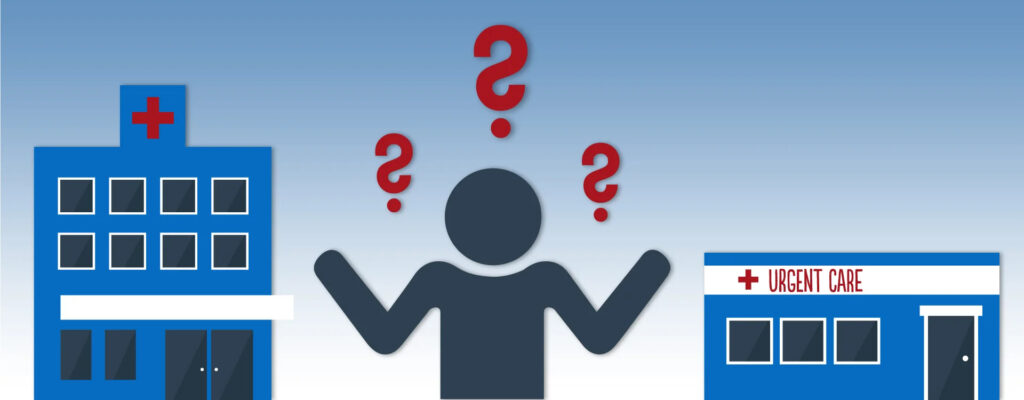What Is the Difference Between Urgent Care and the Emergency Room?

What is urgent care for?
Urgent care centers are medical facilities that provide prompt, walk-in medical attention for non-life-threatening illnesses or injuries. They are designed to offer quick and convenient access to medical care for individuals who cannot wait for an appointment with a primary care physician or who need medical attention outside of regular office hours.
Urgent care can treat conditions like minor cuts, sprains, broken bones, flu-like symptoms, and other non-emergency illnesses and injuries. They also provide diagnostic and laboratory services, such as X-rays and lab tests, to help diagnose and treat patients. Urgent care centers are an important resource for individuals who need medical attention on a walk-in basis.
When should I visit an urgent care doctor?
Urgent care centers are a good alternative to the ER for medical issues that need immediate care but are not life-threatening. They are a good option for non-emergency medical needs such as sprains, animal bites, home accidents, minor fractures, cuts that may need stitches, minor burns, and illnesses like the cold, flu, RSV and other viruses. It is also a good option for those with urgent medical needs but cannot schedule an appointment with their primary care doctor or avoid a trip to the ER. In general, an urgent care center is the best option if the condition is not severe enough to require an ambulance or emergency room visit.
For more guidance on choosing the right care settings, see the CDC’s insights on emergency department usage.
What are the most common reasons for doctor visits?
Doctor visits are almost always situations that require immediate medical attention but are not overly serious. An urgent care facility is a good option because it typically has extended hours, including weekends and holidays, and does not require an appointment. The most common reasons for visits to urgent care centers include minor injuries, such as sprains and fractures, respiratory infections, and gastrointestinal issues.
Other common reasons include minor burns, cuts, lacerations that may require stitches, and minor allergic reactions. In addition to treating illnesses and injuries, many urgent care centers provide preventive care services such as physicals and vaccinations. It is important to note that urgent care should not be used as a replacement for primary care but rather as a convenient option for unexpected medical issues that cannot wait for a scheduled appointment with a primary care physician.
When to Go to the Emergency Room
If you’re experiencing severe symptoms that affects your whole body, such as intense pain, or a high fever that doesn’t go down, or if you’re unable to move an arm or leg or breathe normally, it’s time to call 911 or go to the emergency room. Example of situation that need emergency care include:
- Serious injuries or severe allergic reactions
- Loss of consciousness or symptoms of a stroke or heart attack
In critical cases, it’s often best to go the nearest ER for immediate care, as they have advanced technology and direct hospital connections to ensure you get the care you need quickly.
The American College of Emergency Physicians (ACEP) has guidance on when to call 911. Some common reasons include:
- The condition is life threatening and needs immediate attention
- You’re unable to drive or be transported safely to the ER
What are the reasons for going to urgent care instead of an ER?
Urgent care centers are a convenient and cost-effective alternative to emergency rooms for non-life-threatening medical conditions. One of the main benefits of visiting an urgent care center is shorter wait times. Unlike emergency rooms, which prioritize patients with serious or life-threatening conditions, urgent care centers are designed to treat patients with illnesses or injuries requiring prompt attention but not serious enough for the ER. Additionally, urgent care centers often have extended hours. They are also open on holidays and weekends, helping patients receive prompt medical attention when needed.
Another benefit of urgent care centers is their cost. Urgent care visits are typically less expensive than emergency room visits, and many insurance plans cover the cost of urgent care visits. This can be especially important for patients without insurance or with high-deductible insurance plans.
Urgent care centers also typically have on-site diagnostic equipment and laboratory services, which allow for faster and more accurate diagnosis and treatment. Many urgent care centers have X-ray and other imaging capabilities, which can help identify the cause of an injury or illness.
Urgent care centers offer a convenient and cost-effective alternative to emergency rooms for non-life-threatening medical conditions. With shorter wait times, extended hours, and on-site diagnostic equipment, patients can receive prompt and accurate treatment for various illnesses and injuries.
Doc-Aid is here for your urgent care needs. We have five convenient locations to serve you: three in Urgent Care Laredo Tx: E. Saunders Laredo, TX, Monarch Drive Laredo, TX, and S. Zapata Hwy, as well as two urgent care in the RGV in Pharr and Weslaco. For more information, don’t hesitate to contact us or book an appointment online.



